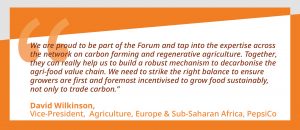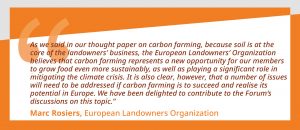Developing and scaling carbon farming in Europe – questions to address?
Caroline Mahr, Forum Programme Director
Wednesday, Dec 08, 2021
In the coming days, the European Commission is expected to publish its communication on sustainable carbon cycles. Reportedly, this will set out the measures it believes will be required to establish sustainable and resilient carbon cycles which can contribute to the legally binding commitment to balance greenhouse gas emissions and removals by 2050 and achieve negative emissions thereafter.
One of likely areas of focus is the need to upscale technological and nature-based solutions which together can, potentially, reduce emissions and increase the capture and storage of CO2 from the atmosphere. In recent months, the Forum has also been exploring this topic with many of our partners and stakeholders with a particular focus on carbon farming. We have sought to understand its potential, how it could be developed and scaled within the European Union, and the co-benefits it might deliver.
During these dialogues, which have taken place during field visits, podcasts, roundtable seminars, and our conference events, there appears to be a general consensus that carbon farming – including agro-forestry, peatland rewetting and the building up of soil organic carbon – can play a role in establishing more sustainable and resilient carbon cycles as well as delivering co-benefits for soil health and biodiversity. It is fair to say, however, that some still have doubts and pose very legitimate questions about the extent of the contribution and whether it can be accurately accounted for.
It seems clear, therefore, that if carbon farming is to play a substantive role in establishing sustainable and resilient carbon cycles, a number of factors will need to be fully considered in its development and scaling in Europe (and beyond).
These certainly appear to include agreement on the definition of carbon farming (and, by association, regenerative agriculture) and the qualifying practices; the setting of robust, harmonised standards, and an approach to monitoring, reporting and verification, (MRV) which would retain the confidence and support of a wide range of stakeholders as well as generate investment certainty. After all, being certain that the practices undertaken by foresters, land managers and farmers, can genuinely lead to verifiable carbon savings and removals is paramount. Addressing the key questions of additionality, avoidance of leakage, no double counting, and – for some, the most important – the guarantee of long-term permanence, will surely be critical in the emerging EU regulatory framework for certifying carbon removals.
The provision of and access to impartial advice and knowledge transfer is consistently raised by potential practitioners. This seems to be critical to any successful scaling of carbon farming in Europe and would help to ensure that all farmers, whatever their size, are able to participate. In the end, the farmer or land manager will need to be deeply convinced of the broader agronomic, environmental and economic benefits, if they are to make the shift, as well as being sure that changes are compatible with their primary role of producing food.
Much has been made of the need to develop new business models around carbon farming which equitably incentivise all participating growers over the long term. These range from green financing to the issuing of high quality, high price carbon credits, (which have the potential to lever in additional revenue from outside the agri-food industry but which remain controversial for some). Others are attracted by the opportunity for the agri-food chain itself to incentivise growers in their supply chains, to switch to carbon farming friendly practices.
Whatever the merits or otherwise of these new business models, few believe that on their own they will be a panacea. To many, the Common Agriculture Policy should play an expanded role in supporting growers in covering costs to make the transition to carbon farming practices and sustaining them thereafter.
Other innovative ideas for incentivisation and the attraction of impact investors have also been heard. These included building accurate risk profiles and/ or, taking a longer-term view of the added value of land where it can be shown to have been demonstrably improved through carbon farming (or broader sustainable agriculture) practices. Some believe this could help to unlock fiscal tax breaks, discounted finance, as well as overall higher land prices.
For those who believe that agriculture can be part of the solution to the climate crisis, carbon farming represents a significant and exciting opportunity. But it is also equally clear that if it is to command confidence and support, as well as investment of time and money, the factors outlined above – and no doubt several others not mentioned here – will need to be addressed in the Commission’s forthcoming communication and in the legislative process that follows.
Views from some of our partners
Caroline Mahr
Forum Programme Director



